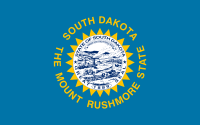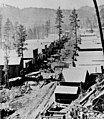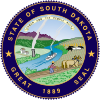Portal:South Dakota
The South Dakota Portal South Dakota (/dəˈkoʊtə/ ⓘ də-KOH-tə; Sioux: Dakȟóta itókaga, pronounced [daˈkˣota iˈtokaga]) is a landlocked state in the North Central region of the United States. It is also part of the Great Plains. South Dakota is named after the Dakota Sioux tribe, which comprises a large portion of the population with nine reservations currently in the state and has historically dominated the territory. South Dakota is the 17th largest by area, but the 5th least populous, and the 5th least densely populated of the 50 United States. Pierre is the state capital, and Sioux Falls, with a population of about 213,900, is South Dakota's most populous city. The state is bisected by the Missouri River, dividing South Dakota into two geographically and socially distinct halves, known to residents as "East River" and "West River". South Dakota is bordered by North Dakota to the north, Minnesota to the east, Iowa to the southeast, Nebraska to the south, Wyoming to the west, and Montana to the northwest. Humans have inhabited the area for several millennia, with the Sioux becoming dominant by the early 19th century. In the late 19th century, European-American settlement intensified after a gold rush in the Black Hills and the construction of railroads from the east. Encroaching miners and settlers triggered a number of Indian wars, ending with the Wounded Knee Massacre in 1890. As the southern part of the former Dakota Territory, South Dakota became a state on November 2, 1889, simultaneously with North Dakota. They are the 39th and 40th states admitted to the union; President Benjamin Harrison shuffled the statehood papers before signing them so that no one could tell which became a state first. Key events in the 20th century included the Dust Bowl and Great Depression, increased federal spending during the 1940s and 1950s for agriculture and defense, and an industrialization of agriculture that has reduced family farming. Eastern South Dakota is home to most of the state's population, and the area's fertile soil is used to grow a variety of crops. West of the Missouri River, ranching is the predominant agricultural activity, and the economy is more dependent on tourism and defense spending. Most of the Native American reservations are in West River. The Black Hills, a group of low pine-covered mountains sacred to the Sioux, is in the southwest part of the state. Mount Rushmore, a major tourist destination, is there. South Dakota has a temperate continental climate, with four distinct seasons and precipitation ranging from moderate in the east to semi-arid in the west. The state's ecology features species typical of a North American grassland biome. (Full article...) Selected article - Sioux is a Siouan language spoken by over 30,000 Sioux in the United States and Canada, making it the fifth most spoken Indigenous language in the United States or Canada, behind Navajo, Cree, Inuit languages, and Ojibwe. Since 2019, "the language of the Great Sioux Nation, comprised of three dialects, Dakota, Lakota, and Nakota" is the official Indigenous language of South Dakota. (Full article...)CategoriesRelated portalsEntries here consist of Good and Featured articles, which meet a core set of high editorial standards.
George Stanley McGovern (July 19, 1922 – October 21, 2012) was an American historian and South Dakota politician who was a U.S. representative and three-term U.S. senator, and the Democratic Party presidential nominee in the 1972 presidential election. McGovern grew up in Mitchell, South Dakota, where he became a renowned debater. He volunteered for the U.S. Army Air Forces upon the country's entry into World War II. As a B-24 Liberator pilot, he flew 35 missions over German-occupied Europe from a base in Italy. Among the medals he received was a Distinguished Flying Cross for making a hazardous emergency landing of his damaged plane and saving his crew. After the war he earned degrees from Dakota Wesleyan University and Northwestern University, culminating in a PhD, and served as a history professor. He was elected to the U.S. House of Representatives in 1956 and re-elected in 1958. After a failed bid for the U.S. Senate in 1960, he was a successful candidate in 1962. (Full article...)General images -The following are images from various South Dakota-related articles on Wikipedia.
Did you know -
TopicsLargest citiesCities in South Dakota, with their populations (as of July 1, 2020, as enumerated by the 2020 United States census):
WikiProjectsNew articlesThis list was generated from these rules. Questions and feedback are always welcome! The search is being run daily with the most recent ~14 days of results. Note: Some articles may not be relevant to this project.
Rules | Match log | Results page (for watching) | Last updated: 2024-04-25 22:24 (UTC) Note: The list display can now be customized by each user. See List display personalization for details.
Associated WikimediaThe following Wikimedia Foundation sister projects provide more on this subject:
Sources
|





















